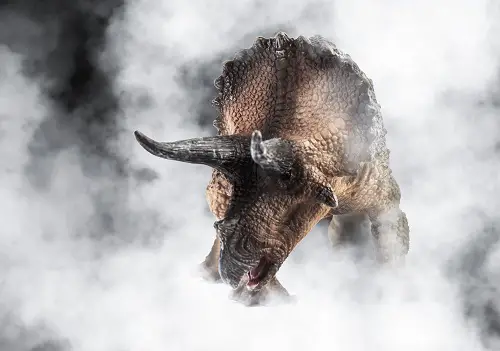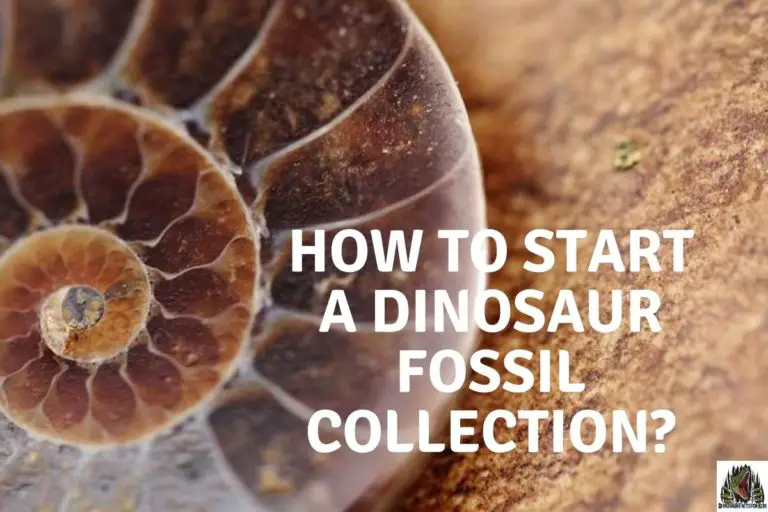What Color Was Triceratops?
As time goes by, scientists and paleontologists are discovering more and more about dinosaurs and what they really looked like, including their color. If you trust Hollywood’s interpretation of what color dinosaurs were, you would see colors that vary from green and brown to grey with oranges and reds. It made me curious about what color Triceratops was.
The color of Triceratops is not known. It has been disputed for many years, but we might soon have an answer with new technological advances. Sources of evidence paleontologists have uncovered about how Triceratops lived; suggest they might have had bright red stripes as an intimidation technique.
There are many new techniques that experts are studying in Paleocolor (the scientific study of what dinosaurs looked like). It means that we can determine the true colors of many dinosaur species with some time and patience. In this post, we will look at what color science says Triceratops was.
What Color Was Triceratops?
The debate on the true color of Triceratops has been ongoing for many years. Most paleontologists agree that because they were closely related to reptiles and birds, their colorings had to be related.
It means that, despite being grey like a rhino or elephant, triceratops could have been much more colorful than the movies have made them out to be,
Triceratops is considered one of the best equipped herbivore dinosaurs to take on or fight large predators. like Tyrannosaurus Rex. Although clearly a prey animal any Large carnivore would have thought twice about taking on this huge armored herbivore.
Today, the birds and reptiles that are the most dangerous are brightly colored to warn predators to keep away from them.
So, scientists have said that it’s very likely that Triceratops was not a muddy brown or mute dark green but could have had bright colors like red or orange stripes as a defense mechanism. This notion is made more believable because birds can see color, so with dinosaurs being so closely related to them, the chances are that dinosaurs could see color too.
On the other hand, some paleontologists and scientists argue that because Triceratops was a herbivore, they had to have brown or green skin used to camouflage their presence from predators. Both points have merit, but as of today, we only know the actual coloring of two dinosaurs.

How Do We Know The Color Of Dinosaurs?
There have been so many new techniques and technological advances in the last two decades that will help us find out in more detail what dinosaurs looked like, including their coloring. While paleontologists have been speculating and debating about the color of dinosaurs, the true color of most are unknown.
When paleontologists find new fossils, all they find are bones and horns. Keep in mind that skin, cartilage, and soft tissue deteriorate first, so it has been almost impossible to find any fossils that have skin or soft tissue still present.
They have found fossilized feather impressions at some point, but that has been the extent of what scientists have been able to find until recently. A new technique has shed some light on the fossil remains that were found of a Psittacosaurus (an early ancestor of Triceratops).
They found some fossilized soft tissue still intact which was unheard of until now, and have used laser technology to determine the actual color of this cousin of the Triceratops. Using lasers, they discovered this Labrador-sized dinosaur had evolved countershading.
Countershading is a pattern that hides the shadows of an animal and helps them appear less visible. So they were able to determine that this cousin of Triceratops was darker on the top of its body and lighter on the bottom of their bodies.
Are There Any Dinosaurs We Do Know The Colors Of?
One of the first dinosaurs that they could determine the color of was an ancient bird like dinosaur called Anchiornis huxleyi. Their technique was based on the study of melanosomes where Jacob Vinthers, a paleontologist at the University of Bristol, discovered that what was previously thought to be bacteria was melanosomes.
These melanosomes carry genetic material that is responsible for the coloring of animals. They found that they could use light, lasers, and microscopes to determine the color of an animal. In this case, they used this technique on the feathers of Anchiornis huxleyi and found the bird liek dinosaur had black feathers with white markings and a head full of red feathers.
This technique has been used to determine the color of a prehistoric extinct mouse. They studied the melanin (the pigment that determines the color of our skin and that of animals) that they found in the fossils of this mouse and discovered that each form of melanin has a distinguishing feature; copper- eumelanin and zinc-pheomelanin.
Knowing this, they used very powerful X-ray beams and bounced them off the fossil melanosomes to map the color reflected back. Using this technique, they determined that this mouse was entirely red in color. Maybe there was even a pink dinosaur.
Why Do We Think Triceratops Was Brightly Colored?
Paleontologists think that Triceratops might have had bright colors. Because Triceratops were herbivores, the idea is that they would have bright red or orange patterns or stripes. They believed that the brightly colored stripes or patterns would have warned predators that Triceratops would not go down without a fight.
Birds and dangerous reptiles are brightly colored to warn predators that they are dangerous, and it’s thought that the same might be the case with dangerous defenders like Triceratops. Bright colors or patterns could also warn other Triceratops to keep away from each other’s territory or potential mates.
Brighter-colored males would have stood out better and gained a better chance at mating with a female. Maybe one day, scientists will use the technique Jacob Vinthers discovered, and we can find out the true color of Triceratops and many other ancient animals.
It is thought that herbivore dinosaurs grew to larger and larger sizes when they lived in more open areas. Living in a forest or dense vegetation allows you to hide or conceal better, living on open plains does not allow this and the best defense may have been deterrence rather than concealment.
Now we know some dinosaurs used speed ( the ostrich like dinosaurs) and some used armour and size. So is it really that far of a stretch to think that some used color ( kind of like reverse psychology – advertising their presence with an I don’t care if you see me attitude! – and used bright colors to try to encourage a predator to look for other, easier and less risky meals.
Reasons Triceratops may have been brightly colored.
- To identify themselves to others of their species.
- To show how strong and healthy they were to females
- To warn predators that they were not an easy meal
- Color is used widely throughout the Animal Kingdom
- More and more dinosaurs are being discovered to have melanin coloring

Melanin was a Major skin pigment in Dinosaurs
The paleoecological data suggests that melanin was a major skin pigment in dinosaurs. Humans, animals, and birds have melanin, and any shade of human hair or skin would be plausible. But what was the purpose of melanin in dinosaurs? Did it contribute to their colour? And what does this mean for the study of dinosaurs?
Many depictions of dinosaurs show striking patterns and colours. Some people dismiss these as a result of artistic license, but paleo-colour scientists have evidence that dinosaurs were indeed bright and colourful.
The skin pigment melanin was preserved in the feathers of dinosaurs and other ancient birds. Hence, scientists have reconstructed their colours. But these paleoecological studies are not yet conclusive.
Scientists can use fossilized melanin granules to determine their relative dark-light body patterns. However, paleoecologists still have not determined the actual colors of most species of dinosaurs.
This is because the paleoecological evidence of dinosaurs is still limited, and the melanin granules cannot be directly compared to those of extant animals.Therefore at the moment Triceratops are green in color
While modern reptiles use pigments for communication, these dinosaurs probably used colours to hide from or warn their predators. Their bright colors may have also been used to attract mates
This is similar to the theory behind why the stegosaurus might have had some color variations which you read more about in the link here and below.
Triceratops Coloring Pages
Until we know for a fact the true color of a triceratops we are free to guess and speculate. So we have some triceratops coloring pages ( and many more dinosaurs as well) for you.
If you wish to color it pink with spots you are free to do so, at the moment, it may be in the next few years we actually do find out the color of these huge dinosaurs and you have to re color them. Good job we made these triceratops coloring pages free then isn’t it! You can get them from the link below or here.
11 Triceratops Colouring pages ( and other horned dinosaurs)
Conclusion
When we think about what Triceratops and other dinosaurs looked like, most of us think of the pictures we see in movies and books, but we are only now starting to scratch the surface of what these extinct animals looked like.
With new and innovative technology, we have been able to determine what a few dinosaurs looked like, and soon we will know even more. Maybe the triceratops was a bright yellow or red striped animal after all!
References
- https://www.wired.co.uk/article/paleocolour-dinosaur-facts
- https://dinosaurpictures.org/Triceratops-pictures
- https://sitn.hms.harvard.edu/flash/2019/color-dinosaur-actually/
- https://www.scienceabc.com/nature/animals/what-color-are-dinosaurs.html#:~:text=Scientists%20determine%20dinosaur%20colors%20by,had%20a%20rusty%20red%20color.
Hi, I am Roy Ford a General Studies and English Teacher who has taught all over the world. What started as a fossil collection became a great way to teach, motivate and inspire students of all ages and all over the world about dinosaurs and from that and children’s love of dinosaurs came the site dinosaur facts for kids, a resource for all ages.










